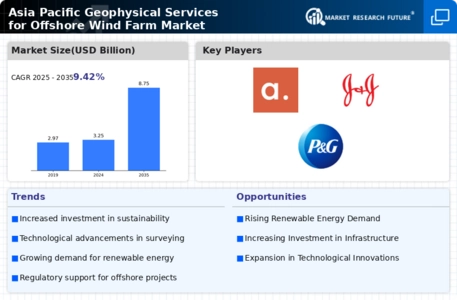The Asia Pacific Geophysical Services for Offshore Wind Farm Market is currently characterized by a dynamic competitive landscape, driven by increasing investments in renewable energy and a growing emphasis on sustainability. Key players such as Fugro (NL), CGG (FR), and Worley (AU) are strategically positioning themselves to capitalize on these trends. Fugro (NL) has focused on enhancing its technological capabilities, particularly in data acquisition and analysis, which is crucial for optimizing offshore wind farm development. Meanwhile, CGG (FR) has been expanding its service offerings through strategic partnerships, thereby enhancing its market presence. Worley (AU) has adopted a comprehensive approach, integrating engineering and environmental services to provide holistic solutions for offshore wind projects. Collectively, these strategies not only bolster their competitive edge but also contribute to a more robust market environment.
In terms of business tactics, companies are increasingly localizing their operations to better serve regional markets, which appears to be a response to the unique challenges posed by offshore wind projects. The market structure is moderately fragmented, with several players vying for market share, yet the influence of major companies remains significant. This competitive structure fosters innovation and encourages collaboration among firms, as they seek to optimize supply chains and enhance service delivery.
In August 2025, Fugro (NL) announced a partnership with a leading technology firm to develop advanced geophysical survey techniques tailored for offshore wind farms. This collaboration is expected to enhance Fugro's data collection capabilities, allowing for more precise site assessments and ultimately reducing project risks. The strategic importance of this partnership lies in its potential to set new industry standards for data accuracy and efficiency, thereby reinforcing Fugro's position as a market leader.
In July 2025, CGG (FR) launched a new suite of geophysical services specifically designed for the offshore wind sector, which includes innovative seismic imaging technologies. This initiative is indicative of CGG's commitment to leveraging cutting-edge technology to meet the evolving needs of the market. By enhancing its service portfolio, CGG aims to attract a broader client base and strengthen its competitive stance in the Asia Pacific region.
In September 2025, Worley (AU) secured a significant contract for the environmental assessment of a major offshore wind project in Australia. This contract underscores Worley’s integrated approach, combining engineering expertise with environmental stewardship. The strategic importance of this contract lies in its potential to enhance Worley’s reputation as a comprehensive service provider, capable of addressing both technical and environmental challenges in offshore wind development.
As of October 2025, the competitive trends in the Asia Pacific Geophysical Services for Offshore Wind Farm Market are increasingly defined by digitalization, sustainability, and the integration of artificial intelligence. Strategic alliances are becoming more prevalent, as companies recognize the value of collaboration in driving innovation and enhancing service delivery. Looking ahead, it is likely that competitive differentiation will evolve, shifting from traditional price-based competition to a focus on technological innovation, reliability in supply chains, and the ability to deliver sustainable solutions. This transition may ultimately reshape the competitive landscape, fostering a more resilient and forward-thinking market.


















Leave a Comment